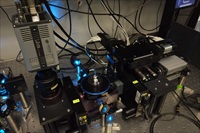Members Login

Channels
Special Offers & Promotions
Fundamentals of Embryo Development uncovered in Real Time
Andor Zyla high-speed cameras power novel four-lens light-sheet microscope to deliver whole embryo images in under ten seconds.
 Understanding embryo development is still one of the most intriguing questions facing today's biologists. Light-sheet microscopy is rapidly gaining recognition for whole organism imaging, allowing cell growth, differentiation and morphogenesis to be studied in detail. However, compared to confocal microscopy, the amount of data generated by this new technique is approximately three thousand times greater and poses new storage and image post-processing challenges.
Understanding embryo development is still one of the most intriguing questions facing today's biologists. Light-sheet microscopy is rapidly gaining recognition for whole organism imaging, allowing cell growth, differentiation and morphogenesis to be studied in detail. However, compared to confocal microscopy, the amount of data generated by this new technique is approximately three thousand times greater and poses new storage and image post-processing challenges.
Rather than deploying ever more massive storage and computing power, a team of researchers from the Max Planck Institute and the Technical University in Dresden, Germany, has dramatically reduced the data rate 240-fold to create the first microscope that processes image data in real-time and provides the researcher with results rather than raw data. Using two high-speed Andor Zyla sCMOS cameras in a specially-designed four-lens selective plane illumination microscope (SPIM) with on-board image processing, the team delivered undistorted, high-resolution images of the entire endoderms of multiple zebrafish embryos in less than ten seconds.
According to Jan Huisken, the Research Group Leader at the Max Planck Institute, "We exploited the spherical geometry of the embryos and the speed and sensitivity of the Zyla sCMOS camera to compute a radial maximum intensity projection of each individual embryo during image acquisition. An entire zebrafish embryo can now be instantaneously projected onto a 'world map' to visualize all endodermal cells and follow their fate. This reveals characteristic migration patterns and global tissue remodelling in the early endoderm and, by merging data from many samples, we have uncovered stereotypical patterns that are fundamental to embryo development."
"The raw data from the Zyla cameras were not saved at any point, which means that any 3D information not captured in the projection is lost. However, the radial projection delivers immediate, pre-processed data for analysis and enables experiments to be repeated very rapidly. This new technique will not eliminate the need for slow 3D imaging techniques in more complex shapes but it is a highly effective strategy to streamline further analysis and increase throughput in many applications."
Orla Hanrahan, Application Specialist at Andor, says "Image processing in real-time is a major advance for researchers who recognise that statistical, large-scale analysis is impossible when single experiments produce approx. 13Tb of data. Jan Huisken's novel microscope dramatically reduces the data collected so that many experiments can be performed, which is absolutely crucial to describe and understand the diversity seen in embryo development. At the same time, the data is projected in a convenient way to facilitate further analysis and this principle can also be used to address other questions in developmental biology.
"Two of our new Zyla sCMOS cameras are used in novel microscope, offering high-speed, high-sensitivity imaging performance in a compact, TE cooled design. Zyla is ideally suited to cutting-edge applications that push the boundaries of speed, offering sustained 100 frames per second performance."
Media Partners


